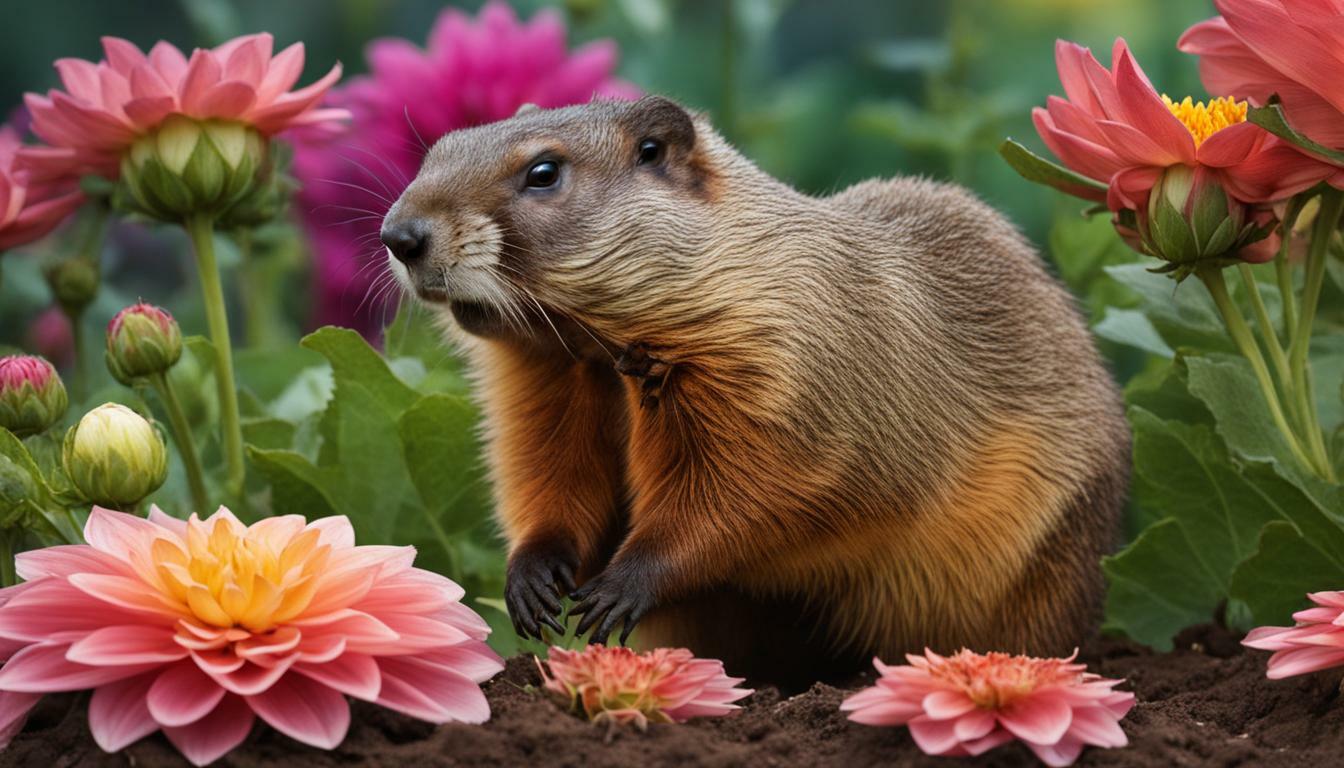Groundhogs, also known as woodchucks, are known to have a varied diet that includes both edible and ornamental plants, such as dahlias. These creatures can be attracted to gardens and pose a threat to your beloved flowers. Understanding their dietary habits and finding effective ways to protect your dahlias is crucial in maintaining a thriving garden.
Key Takeaways:
- Groundhogs, or woodchucks, have a diverse diet that includes dahlias.
- To deter groundhogs from your garden, consider growing plants they don’t like.
- Techniques such as using groundhog repellent, fencing, and blocking burrows can help discourage groundhogs.
- Take precautions when dealing with groundhogs to avoid injury.
- If necessary, professional wildlife trappers can be hired for groundhog removal.
Understanding Groundhog Behavior
In order to understand why groundhogs may target dahlias in your garden, it is important to delve into their behavior patterns and natural instincts. Groundhogs, also known as woodchucks, are herbivorous rodents that are well-known for their burrowing habits. They are primarily active during the day and tend to forage for food in the early morning and late afternoon.
Groundhogs have a varied diet that includes grasses, clover, berries, and vegetables. While they typically prefer plant material that is easily accessible, they have been known to eat a wide range of plants, including dahlias. These creatures can be attracted to gardens due to the abundance of food sources and the shelter provided by vegetation and structures. They will often target plants that are young, tender, and easily reachable.
To protect your dahlias and other prized plants, it is important to implement strategies that discourage groundhogs from your garden. One effective method is to grow plants that groundhogs tend to avoid, such as daffodils, marigolds, or lavender. These plants have strong scents or unpalatable characteristics that can deter groundhogs from feeding on them.
Groundhog Behavior at a Glance:
| Behavioral Aspect | Description |
|---|---|
| Burrowing | Groundhogs are skilled diggers that create extensive burrow systems for shelter and hibernation. |
| Diurnal Activity | Groundhogs are most active during the day, foraging for food in the early morning and late afternoon. |
| Herbivorous Diet | Groundhogs primarily feed on grasses, clover, berries, vegetables, and various other plants. |
| Plant Preferences | While groundhogs have a varied diet, they may target young, tender plants, including dahlias, especially if they are easily accessible. |
| Burrow Defenses | Groundhogs are protective of their burrows and will aggressively defend them if they feel threatened. |
In addition to planting groundhog-resistant plants, other strategies worth considering include using groundhog repellents, erecting fencing or barriers around your garden, or blocking groundhog burrows to prevent access. Keep in mind that groundhogs are wild animals and caution should be exercised when dealing with them. It is advisable to avoid cornering them, and it is best to contact professional wildlife trappers if the situation becomes unmanageable or if you are unsure of how to handle them safely.
By understanding groundhog behavior and implementing effective deterrents, you can protect your garden and enjoy the beauty of your dahlias without the risk of damage caused by these curious and hungry creatures.
Impact of Groundhogs on Dahlia Plants
Groundhogs, with their voracious appetite and burrowing tendencies, can wreak havoc on delicate dahlia plants, causing significant damage to stems, leaves, and even flowers. These adorable creatures may be charming to observe but can quickly turn into a gardener’s worst nightmare. If you’ve invested time and effort into cultivating a beautiful dahlia garden, it’s essential to understand the potential risks posed by groundhogs and how to protect your precious blooms.
When groundhogs find their way into your garden, they won’t hesitate to feast on your prized dahlias. They have a wide-ranging diet and are known to devour not only edible plants but also ornamentals like dahlias. The damage inflicted by groundhogs can vary, from nibbling on leaves and stems to completely decimating flowers. This plant devastation can be disheartening for any gardening enthusiast.
To prevent groundhog-induced damage, consider implementing various strategies. Firstly, planting groundhog-resistant plants alongside your dahlias can help divert their attention away from your beloved flowers. Include plants like marigolds, daffodils, and lavender, which groundhogs tend to avoid. Secondly, employing natural groundhog repellents can keep them at bay. From homemade concoctions of chili powder and garlic spray to commercially available repellents, these deterrents can help safeguard your dahlias.
In addition to repellents, physical barriers like fences or barriers around burrows can effectively keep groundhogs out of your garden. A sturdy fence buried at least a foot underground will prevent them from burrowing into your garden beds. However, it’s crucial to regularly check for any signs of digging and reinforce the barriers if necessary. If these preventive measures don’t yield the desired results, seeking professional assistance for groundhog control may be necessary to protect your precious dahlia blooms.
| Dahlia Damage | Preventive Measures |
|---|---|
| Nibbled leaves and stems | Plant groundhog-resistant plants |
| Complete flower destruction | Use natural groundhog repellents |
| Digging and burrowing | Install physical barriers such as fences |
| Consult professionals for groundhog control |
While dealing with groundhogs, it’s important to exercise caution. These wild animals possess sharp teeth and claws and can be aggressive if they feel threatened. Avoid cornering them or provoking them, and always keep a safe distance. Ensure that children and pets are kept away from groundhogs to prevent any potential harm.
Natural Ways to Keep Groundhogs Away
If you want to protect your dahlias and keep groundhogs at bay, there are several natural methods you can employ to discourage their presence in your garden. Groundhogs, also known as woodchucks, can be attracted to gardens and cause significant damage to plants, including dahlias. By implementing these natural solutions, you can create a garden environment that is less appealing to these pesky critters.
One effective method is to grow plants that groundhogs don’t like. These include herbs like mint and lavender, as well as flowers such as daffodils and marigolds. The strong scents and tastes of these plants can act as natural deterrents, making your garden less inviting to groundhogs.
Another approach is to use groundhog repellents. There are various commercially available repellents that use organic ingredients like garlic, pepper, and castor oil. These natural substances emit odors that groundhogs find unpleasant, encouraging them to stay away from your garden.
Fencing and barriers can also be effective in preventing groundhogs from accessing your garden. Use sturdy fencing with an underground barrier to deter them from burrowing underneath. Additionally, consider installing wire mesh around garden beds or plantings to create a physical barrier that groundhogs cannot easily breach.
| Methods | Effectiveness |
|---|---|
| Growing groundhog-resistant plants | Medium |
| Using groundhog repellents | Medium |
| Fencing and barriers | High |
It is important to take precautions when dealing with groundhogs, as they are wild animals with sharp teeth and claws. It is best to avoid cornering them or allowing children and pets to approach them. If your efforts to deter groundhogs are ineffective, consider seeking the assistance of professional wildlife trappers who specialize in groundhog removal.
By implementing these natural methods and maintaining a vigilant approach, you can protect your dahlias and maintain a garden that is inhospitable to groundhogs. Remember, prevention is key, so be proactive in deterring these garden invaders to enjoy a beautiful and thriving garden all season long.
Planting Groundhog-Resistant Plants
To minimize the risk of groundhog damage to your dahlias, consider incorporating plants into your garden that are known to be less appealing to these furry intruders. By selecting plants that groundhogs are less likely to eat, you can help protect your precious flowers and maintain a beautiful garden.
When it comes to groundhog prevention, there are several options to consider. One approach is to choose plants with strong scents or tastes that groundhogs find unappealing. Some examples of plants that are often considered groundhog-resistant include daffodils, marigolds, lavender, and catnip. These plants not only add beauty to your garden but also act as natural deterrents, making them less attractive to these persistent pests.
Another strategy is to focus on plants that have tough or prickly foliage, as groundhogs tend to avoid plants with thorns or spines. Consider incorporating plants such as roses, barberry, or Russian sage into your garden to create barriers that deter groundhogs from venturing near your dahlias.
| Groundhog-Resistant Plants | Characteristics |
|---|---|
| Daffodils | Strong scent deters groundhogs |
| Marigolds | Pungent odor and bitter taste repel groundhogs |
| Lavender | Fragrant and disliked by groundhogs |
| Catnip | Strong scent repels groundhogs |
| Roses | Thorny stems deter groundhogs |
| Barberry | Sharp spines discourage groundhogs |
| Russian Sage | Fuzzy foliage disliked by groundhogs |
By incorporating these groundhog-resistant plants into your garden, you can create a more unwelcoming environment for these pests, helping to safeguard your dahlias and other cherished plants.
Using Groundhog Repellent
Groundhog repellents can be an effective tool in discouraging these rodents from feasting on your dahlias, making them a valuable addition to your pest control arsenal. By utilizing repellents, you can create a barrier that deters groundhogs from entering your garden and causing damage to your beloved flowers.
There are several types of groundhog repellents available on the market, each with its own method of deterring these pests. One popular option is using scents that groundhogs find unpleasant, such as predator urine or strong essential oils like peppermint or castor oil. These scents mask the attractive smells of your dahlias, making them less appealing to groundhogs.
Another effective method is using granular repellents. These products are typically made from natural ingredients and can be sprinkled around your garden or specific areas where groundhogs are active. The granules emit odors that groundhogs dislike, creating a barrier that they are less likely to cross.
| Groundhog Repellent Options | Pros | Cons |
|---|---|---|
| Scents (predator urine, essential oils) | – Natural and environmentally friendly – Easy to apply – Multiple scent options available |
– May need frequent reapplication – Strong scents may be unpleasant to some |
| Granular repellents | – Long-lasting protection – Easy to apply – Provides a physical barrier |
– May not be as effective in heavy rain – Can be harmful to other beneficial wildlife if not used properly |
When using groundhog repellents, it’s important to follow the instructions provided by the manufacturer. Apply the repellent as directed, paying close attention to the recommended frequency of application. Remember to reapply after heavy rain to ensure continued effectiveness.
Summing It Up
- Groundhog repellents can help deter these pests from your garden and protect your dahlias.
- Options include scents like predator urine or essential oils, as well as granular repellents.
- Follow the instructions provided by the manufacturer for best results.
By using groundhog repellents in combination with other preventive measures, such as fencing or choosing groundhog-resistant plants, you can create a garden environment that is less attractive to these hungry rodents. Remember to prioritize the safety of yourself, children, and pets when dealing with groundhogs, as they are wild animals with the potential to bite or scratch when cornered. With the right precautions and pest control methods, you can enjoy your beautiful dahlias without worrying about groundhog damage.
Fencing and Barriers
Erecting sturdy fences and implementing other types of barriers can be an effective way to keep groundhogs from gaining access to your garden and devouring your precious dahlias. Groundhogs are skilled diggers, so it’s crucial to ensure that any fence or barrier is buried at least 1-2 feet below the ground to prevent them from burrowing underneath.
A suitable fence for groundhog prevention should be at least 3-4 feet high and made of materials that are difficult for them to climb, such as wire mesh or chicken wire. Ideally, the gaps in the fencing should be no larger than 1 inch to prevent groundhogs from squeezing through.
Another option is to install electric fencing or an electric wire around the perimeter of your garden. This can be an effective deterrent as groundhogs will receive a harmless but startling shock if they attempt to breach the barrier. Remember to follow local regulations and safety guidelines when installing electric fencing.
| Pros of Fencing and Barriers | Cons of Fencing and Barriers |
|---|---|
|
|
Remember to regularly inspect and maintain any fences or barriers to ensure they remain intact and effective. Additionally, consider installing barriers around potential groundhog burrows by burying mesh wire around the entrance to prevent them from returning to established dens.
Professional Groundhog Control
If your efforts to deter groundhogs from your garden have been unsuccessful, it may be wise to consider hiring professional wildlife trappers who specialize in groundhog removal. These professionals have the expertise and experience to safely and effectively deal with groundhog infestations, ensuring the protection of your precious dahlias.
When selecting a professional wildlife trapper, look for someone who is licensed and insured. They should also have a thorough understanding of groundhog behavior and control methods. A reputable trapper will assess the extent of the groundhog problem, identify entry points and burrows, and develop a customized plan to remove the groundhogs from your property.
Professional groundhog control methods typically involve a combination of trapping, exclusion, and habitat modification. Traps are strategically placed near burrows or feeding areas and are designed to capture groundhogs safely. Once trapped, the groundhogs will be relocated to a suitable habitat away from residential areas.
| Benefits of Professional Groundhog Control | Considerations |
|---|---|
|
|
It is important to note that professional groundhog control may come at a cost. The fees for trapping and removal services can vary depending on the severity of the infestation and the location of your property. Additionally, ongoing maintenance may be required to prevent future groundhog activity.
Before hiring a professional trapper, consider exploring other methods of groundhog control discussed earlier in this article. However, if your efforts have proven unsuccessful or if the groundhog problem is causing significant damage to your dahlias, professional assistance may be the most effective solution. Remember to always prioritize your safety and consult with experts before taking any action regarding groundhog removal.
Potential Dangers and Precautions
While groundhogs may seem harmless, it is crucial to exercise caution when encountering them, as they are wild animals with sharp teeth and claws that can cause injury if provoked. Here are some important precautions to keep in mind when dealing with groundhogs:
- Avoid approaching or cornering groundhogs, as they may feel threatened and try to defend themselves. It’s best to observe them from a safe distance and give them space to retreat.
- Keep children and pets away from groundhogs, as their curiosity and unpredictability can lead to dangerous situations. Remind children not to approach or try to touch these animals.
- Do not attempt to handle or capture groundhogs without proper training or equipment. They have strong jaws and sharp claws that can cause harm, and they may carry diseases such as rabies.
- If you notice a groundhog burrow in your garden, be cautious when inspecting or blocking it. Groundhogs may be inside or nearby, and sudden movements or noises can startle them, leading to aggressive behavior.
- If you encounter a groundhog that appears injured, sick, or behaving strangely, it’s best to contact local animal control or wildlife rehabilitation centers for assistance. They have the knowledge and resources to handle these situations safely.
By following these precautions, you can minimize the risk of injury or conflict when dealing with groundhogs and ensure the safety of yourself, your family, and your pets.
| Precautions | Reasons |
|---|---|
| Avoid approaching or cornering groundhogs | Groundhogs may feel threatened and defend themselves |
| Keep children and pets away from groundhogs | Curiosity and unpredictability can lead to dangerous situations |
| Do not attempt to handle or capture groundhogs | Strong jaws and sharp claws can cause harm; groundhogs may carry diseases |
| Be cautious when inspecting or blocking groundhog burrows | Groundhogs may be inside or nearby, and sudden movements can startle them |
| Contact local animal control or wildlife rehabilitation centers for assistance with injured or sick groundhogs | These organizations have the expertise and resources to handle such situations safely |
Protecting Your Garden Year-Round
By implementing year-round strategies and remaining vigilant, you can ensure that your garden remains a groundhog-free zone, safeguarding your dahlias and other beloved plants. Here are some effective methods for ongoing groundhog prevention:
- Plant selection: Choose plants that groundhogs are less likely to eat. While groundhogs have a wide range of food preferences, there are certain plants that they tend to avoid. Consider incorporating groundhog-resistant plants into your garden, such as daffodils, marigolds, or lavender, which can act as natural repellents.
- Groundhog repellents: Utilize natural repellents, such as homemade sprays or commercially available deterrents, to create an unpleasant scent or taste that groundhogs find unappealing. Be sure to follow the instructions carefully and reapply as needed.
- Fencing and barriers: Install a sturdy fence around your garden to create a physical barrier that deters groundhogs. The fence should be buried at least a foot underground to prevent groundhogs from burrowing underneath. Additionally, consider placing barriers, like mesh or wire, around the base of individual plants to provide extra protection.
- Regular maintenance: Keep your garden well-maintained by removing any debris or tall grass that could attract groundhogs. Trim back overgrown vegetation and eliminate potential hiding spots. Regularly inspect your garden for signs of groundhog activity, such as burrows or chewed plants, and take immediate action if necessary.
Table: Groundhog-Resistant Plants
| Plant | Characteristics |
|---|---|
| Daffodils | Produces toxic compounds that groundhogs avoid. |
| Marigolds | Strong odor repels groundhogs. |
| Lavender | Has a scent that groundhogs find unpleasant. |
By combining these preventive measures with regular monitoring and prompt action, you can create an environment that is less attractive to groundhogs and minimize the risk of damage to your dahlias. Remember to prioritize your safety when dealing with groundhogs and consider seeking professional assistance if needed. With a proactive approach, you can enjoy a flourishing garden while keeping those groundhogs at bay.
Balancing Wildlife Conservation and Garden Protection
Finding a middle ground between preserving groundhogs as part of the ecosystem and protecting your gardening investments can be a challenging yet achievable goal. As much as we appreciate the role that groundhogs play in the natural world, their appetite for our cherished plants can be frustrating. Fortunately, there are ways to strike a balance that allows both groundhogs and our gardens to thrive.
One approach is to create designated areas within your garden where groundhogs are welcome. By strategically planting groundhog-friendly plants away from your prized dahlias, you can divert their attention to these areas while safeguarding your most beloved flowers. This not only benefits the groundhogs by providing them with a food source, but it also helps preserve your beloved blooms.
In cases where groundhog prevention measures are necessary, it’s important to approach their control with respect and care. While lethal methods may be effective, they should be used as a last resort. Instead, consider non-lethal options such as live trapping and relocating groundhogs to suitable habitats. Professional wildlife trappers can provide guidance on the most humane and effective strategies for groundhog control.
| Groundhog Control Techniques | Pros | Cons |
|---|---|---|
| Live Trapping and Relocation | – Humane approach – Allows groundhogs to be relocated to suitable habitats |
– Requires ongoing trapping and relocation efforts – Groundhogs may return if suitable habitat is nearby |
| Fencing and Barriers | – Physical deterrent – Prevents groundhogs from accessing the garden |
– Can be labor-intensive to install – Groundhogs may dig under or climb over fences |
| Groundhog Repellent | – Non-harmful option – Disrupts groundhog’s sense of smell or taste |
– Effectiveness may vary – Requires regular reapplication |
Remember, it’s essential to take precautions when dealing with groundhogs. These animals are wild and, when cornered, can become defensive. To ensure your safety and that of your family and pets, it’s best to observe groundhogs from a distance and avoid approaching them. Teaching children about the importance of respecting wildlife boundaries is also crucial.
By finding a balance between wildlife conservation and garden protection, you can coexist with groundhogs in a way that allows both your garden and these creatures to thrive. With careful planning, the right control techniques, and a respect for the natural world, you can enjoy the beauty of your dahlias while still appreciating the role that groundhogs play in our ecosystem.
Conclusion
Groundhogs’ love for dahlias can be a frustrating reality for garden enthusiasts, but with the right knowledge and proactive measures, you can successfully defend your beloved flowers from these hungry intruders.
One effective way to protect your dahlias is by understanding groundhog behavior and implementing natural deterrents. Groundhogs have a diverse diet and are known to consume both edible and ornamental plants, including dahlias. By selecting plants that groundhogs don’t particularly like, you can reduce the risk of damage to your garden.
Various techniques can be employed to discourage groundhogs from entering your garden. Using groundhog repellents, erecting fencing or barriers, and blocking their burrows are all effective ways to keep these pests at bay. If all else fails, professional wildlife trappers can be called upon for groundhog removal.
While dealing with groundhogs, it is crucial to exercise caution as they are wild animals with sharp teeth and claws. Avoid cornering them and refrain from allowing children and pets to approach them. By taking appropriate precautions, you can ensure everyone’s safety while defending your dahlia garden.
FAQ
Do groundhogs eat dahlias?
Yes, groundhogs can eat dahlias and cause damage to these plants.
What other plants do groundhogs eat?
Groundhogs have a wide-ranging diet and can consume both edible and ornamental plants, including vegetables, fruits, flowers, and shrubs.
How can I deter groundhogs from my garden?
There are various methods you can try to keep groundhogs away, such as using groundhog repellent, installing fencing or barriers, or employing natural deterrents like certain plants that groundhogs dislike.
Can I hire a professional to remove groundhogs from my property?
Yes, professional wildlife trappers can be hired to safely remove groundhogs from your garden or property.
Are groundhogs dangerous?
Groundhogs are wild animals with sharp teeth and claws, so it’s important to take precautions and avoid cornering them or allowing children and pets to approach them.
How can I protect my dahlias year-round?
By implementing various groundhog prevention techniques, such as using repellents, fencing, and choosing groundhog-resistant plants, you can help safeguard your dahlias throughout the year.




